3D Geological Modeling and Metallogenic Prediction of Kamust Sandstone-Type Uranium Deposit in the Eastern Junggar Basin, NW China
Abstract
1. Introduction
2. Geological Background of the Study Area
3. Key Ore-Controlling Factors and Exploration Model
3.1. Internal and External Uranium Sources
3.2. Structural Control of Ore Deposits
3.3. Lithology–Lithofacies Control of Ore Deposits
3.4. Interlayer Oxidation
3.5. Uranium Mineralization Characteristics
4. Data Preprocessing from Multiple Sources and the 3D Modeling Process
4.1. Data Preprocessing from Multiple Sources
4.2. Modeling Process
4.3. Ore-Forming Prediction
5. 3D Geological Modeling of the Mining Area
5.1. Borehole Model
5.2. Structural-Stratigraphic Model
5.3. Interlayer Oxidation Zone Model
5.4. Source Area Model
6. Ore-Forming Favorable Information Extraction and Deep Ore-Prospecting Prediction
6.1. Extraction of Favorable Stratigraphic Information
6.2. Structural Zone Information Extraction
6.3. Extraction of Interlayer Oxidation Zone Information
6.4. Three-Dimensional Predictive Quantitative Model
6.5. Comprehensive Information Analysis and Prediction
6.5.1. 3D Evidential Belief Functions Method
6.5.2. 3D Information Entropy Methods
6.5.3. Delineation of Prospective Ore-Forming Areas
6.6. Ore-Prospecting Prediction
7. Conclusions
- The study concentrates on the Kamust uranium deposit, adopting a holistic methodology to ascertain the type, location, depth, and quantity of ore. Through the application of three-dimensional geological modeling and visualization technologies, we have developed an intricate 3D model database for the Kamust deposit. This database consolidates various elements, such as drill holes, uranium ore bodies, controlling structures within the mining area, interlayer oxidation zones, and source areas. It facilitates the transparent visualization of the spatial distribution of the favorable ore-forming strata, structures, and other predictive elements within the mining area;
- Based on the three-dimensional geological model, we have summarized and generalized the regional ore-forming mechanisms, ore-controlling elements, and exploration indicators to establish a predictive model for ore discovery. This model, when integrated with big-data technology, enables the quantitative analysis and extraction of ore-controlling elements, offering substantial data support for the in-depth three-dimensional quantitative prediction of the Kamust uranium deposit;
- This research applies both the 3D evidential belief function method and the 3D information entropy method to perform a comprehensive information analysis and a deep ore formation prediction for the Kamust uranium deposit area. Through this approach, we have quantitatively delineated a prospective ore-forming area, situated to the east of the Kalasayi monocline.
Author Contributions
Funding
Data Availability Statement
Conflicts of Interest
References
- Cai, Y.; Zhang, J.; Li, Z.; Guo, Q.; Song, J.; Fan, H.; Liu, W.; Qi, F.; Zhang, M. Outline of Uranium Resources Characteristics and Metallogenetic Regularity in China. Acta Geol. Sin. (Engl. Ed.) 2015, 89, 918–937. [Google Scholar]
- Li, Z.Y.; Huang, Z.Z.; Li, X.Z.; Guo, J.; Fan, C. The Discovery of Natural Native Uranium and Its Significance. Acta Geol. Sin. (Engl. Ed.) 2015, 89, 1561–1567. [Google Scholar]
- Xing, W.; Wang, A.; Yan, Q.; Chen, S. A study of China’s uranium resources security issues: Based on analysis of China’s nuclear power development trend. Ann. Nucl. Energy 2017, 110, 1156–1164. [Google Scholar] [CrossRef]
- Xu, D.; Chi, G.; Nie, F.; Fayek, M.; Hu, R. Diversity of uranium deposits in China—An introduction to the Special Issue. Ore Geol. Rev. 2021, 129, 103944. [Google Scholar] [CrossRef]
- Zhang, H.; Bai, Y. China’s Access to Uranium Resources; The Project on Managing the Atom, Belfer Center for Science and International Affairs, Harvard University: Cambridge, MA, USA, 2015. [Google Scholar]
- Bai, Y.; Guo, C.Y.; Zhu, P.F.; Tian, J.J.; He, Z.L. Three-Dimensional Prediction and Evaluation of Baiyanghe Uranium Deposit in the Xuemistan Volcanic Belt, Xinjiang. Minerals 2023, 13, 1408. [Google Scholar] [CrossRef]
- Fu, G.M.; Lü, Q.T.; Yan, J.Y.; Farquharson, C.G.; Qi, G.; Zhang, K.; Zhang, Y.Q.; Wang, H.; Luo, F. 3D mineral prospectivity modeling based on machine learning: A case study of the Zhuxi tungsten deposit in northeastern Jiangxi Province, South China. Ore Geol. Rev. 2021, 131, 104010. [Google Scholar] [CrossRef]
- Zhang, C.; Liu, S.; Ye, F.; Qiu, J.; Zhang, Z.; Wang, J. Three-dimensional modeling of alteration information with hyperspectral core imaging and application to uranium exploration in the Heyuanbei uranium deposit, Xiangshan, Jiangxi, China. J. Appl. Remote Sens. 2019, 13, 1. [Google Scholar] [CrossRef]
- Fitzpatrick, A.; Large, P. Magnetic modelling and geological modelling come together at the Kintyre uranium deposit. ASEG Ext. Abstr. 2019, 2015, 1–4. [Google Scholar] [CrossRef]
- Freire, R.C.; Veríssimo, C.U.V.; Parente, C.V.; Nogueira Neto, J.D.A.; Castro, G.L.; Silva, J.R.D.A. Three-dimensional geological modeling of the Itataia Phosphate-Uranium Deposit (Ceará, Brazil). Braz. J. Geol. 2022, 52, e20210022. [Google Scholar] [CrossRef]
- Wu, Q.; Wang, Y.; Li, Z.; Qiao, B.; Yu, X.; Huang, W.; Cao, C.; Li, Z.; Pan, Z.; Huang, Y. 2D and 3D Seismic Survey for Sandstone-Type Uranium Deposit and Its Prediction Patterns, Erlian Basin, China. Minerals 2022, 12, 559. [Google Scholar] [CrossRef]
- Jalloh, A.B.; Kyuro, S.; Jalloh, Y.; Barrie, A.K. Integrating artificial neural networks and geostatistics for optimum 3D geological block modeling in mineral reserve estimation: A case study. Int. J. Min. Sci. Technol. 2016, 26, 581–585. [Google Scholar] [CrossRef]
- Qu, H.; Liu, H.; Tan, K.; Zhang, Q. Geological Feature Modeling and Reserve Estimation of Uranium Deposits Based on Multiple Interpolation Methods. Processes 2022, 10, 67. [Google Scholar] [CrossRef]
- Xie, J.; Wang, G.; Sha, Y.; Liu, J.; Wen, B.; Nie, M.; Zhang, S. GIS prospectivity mapping and 3D modeling validation for potential uranium deposit targets in Shangnan district, China. J. Afr. Earth Sci. 2017, 128, 161–175. [Google Scholar] [CrossRef]
- Cao, X.; Liu, Z.; Hu, C.; Song, X.; Quaye, J.A.; Lu, N. Three-Dimensional Geological Modelling in Earth Science Research: An In-Depth Review and Perspective Analysis. Minerals 2024, 14, 686. [Google Scholar] [CrossRef]
- Wang, Y.; Chen, J.; Jia, D. Three-Dimensional Mineral Potential Mapping for Reducing Multiplicity and Uncertainty: Kaerqueka Polymetallic Deposit, QingHai Province, China. Nat. Resour. Res. 2020, 29, 365–393. [Google Scholar] [CrossRef]
- Tan, Y.; Lu, L.; Yang, C.; Zhao, J.; Ding, Y. Uranium-Bearing Layers of Sandstone Type Uranium Deposits Identification and Three-Dimensional Reconstruction in the Northern Ordos Basin, North-Central China. Minerals 2023, 13, 834. [Google Scholar] [CrossRef]
- Xiao, K.; Xiang, J.; Fan, M.; Xu, Y. 3D Mineral Prospectivity Mapping Based on Deep Metallogenic Prediction Theory: A Case Study of the Lala Copper Mine, Sichuan, China. J. Earth Sci. 2021, 32, 348–357. [Google Scholar] [CrossRef]
- Li, Z.Y.; Fang, X.H.; Chen, A.P.; Ou, G.X.; Xiao, X.J.; Sun, Y.; Liu, C.Y.; Wang, Y. Origin of gray-green sandstone in ore bed of sandstone type uranium deposit in north Ordos Basin. Sci. China Ser. D Earth Sci. 2007, 50, 165–173. [Google Scholar] [CrossRef]
- IAEA. World Distribution of Uranium Deposits (UDEPO) with Uranium Deposit Classification; IAEA: Vienna, Austria, 2009. [Google Scholar]
- Cuney, M.; Mercadier, J.; Bonnetti, C. Classification of Sandstone-Related Uranium Deposits. J. Earth Sci. 2022, 33, 236–256. [Google Scholar] [CrossRef]
- Yan, D.; Zhu, R.; Liu, W.; Liu, R.; Shou, H.; Cheng, X.; Cai, Y.; Lei, Z.; Deng, P.; Peng, Y. Metallogenic characteristics and models of sandstone-type uranium deposits in China. Ore Geol. Rev. 2024, 166, 105937. [Google Scholar] [CrossRef]
- Li, G.H.; Yao, J.; Song, Y.M.; Tang, J.Y.; Han, H.D.; Cui, X.D. A Review of the Metallogenic Mechanisms of Sandstone-Type Uranium Deposits in Hydrocarbon-Bearing Basins in China. Eng 2023, 4, 1723–1741. [Google Scholar] [CrossRef]
- Chen, Y.; Miao, P.; Li, J.; Jin, R.; Zhao, H.; Chen, L.; Wang, C.; Yu, H.; Zhang, X. Association of Sandstone-Type Uranium Mineralization in the Northern China with Tectonic Movements and Hydrocarbons. J. Earth Sci. 2022, 33, 289–307. [Google Scholar] [CrossRef]
- Huang, S.; Qin, M.; Liu, Z.; Xiao, J.; Liu, N. Spatiotemporal relationship between hydrocarbon fluid and sandstone-hosted uranium deposits in the Qianjiadian area, Songliao Basin. Geol. J. 2024, 59, 1148–1170. [Google Scholar] [CrossRef]
- Jin, R.; Liu, H.; Li, X. Theoretical System of Sandstone-Type Uranium Deposits in Northern China. J. Earth Sci. 2022, 33, 257–277. [Google Scholar] [CrossRef]
- Liu, Z.Y.; Peng, S.P.; Qin, M.K.; Huang, S.H.; Geng, Y.Y.; He, Z.B. Constraints on Sandstone-Type Uranium Deposits by the Tectonic Uplift and Denudation Process in the Eastern Junggar Basin, Northwest China: Evidence from Apatite Fission Track and Detrital Zircon U-Pb Ages. Minerals 2022, 12, 905. [Google Scholar] [CrossRef]
- Nie, F.; Yan, Z.; Feng, Z.; Li, M.; Xia, F.; Zhang, C.; Wang, Y.; Yang, J.; Kang, S.; Shen, K. Genetic models and exploration implication of the paleochannel sandstone-type uranium deposits in the Erlian Basin, North China—A review and comparative study. Ore Geol. Rev. 2020, 127, 103821. [Google Scholar] [CrossRef]
- Qin, M.K.; Huang, S.H.; He, Z.B.; Xu, Q.; Song, J.Y.; Liu, Z.Y.; Guo, Q. Evolution of Tectonic Uplift, Hydrocarbon Migration, and Uranium Mineralization in the NW Junggar Basin: An Apatite Fission-Track Thermochronology Study. Acta Geol. Sin. (Engl. Ed.) 2018, 92, 1901–1916. [Google Scholar] [CrossRef]
- Zhang, C. Episodic sandstone-type uranium mineralization in Asia during the Late Mesozoic-Cenozoic. Sci. China Earth Sci. 2023, 66, 2034–2044. [Google Scholar] [CrossRef]
- Zhang, L.; Liu, C.; Zhang, S.; Fayek, M.; Lei, K.; Quan, X. Unconformity-controlled bleaching of Jurassic-Triassic sandstones in the Ordos Basin, China. J. Pet. Sci. Eng. 2022, 211, 110154. [Google Scholar] [CrossRef]
- Zhang, F.; Jiao, Y.; Wu, L.; Rong, H. Roles of dispersed organic matters in sandstone-type uranium mineralization: A review of geological and geochemical processes. Ore Geol. Rev. 2021, 139, 104485. [Google Scholar] [CrossRef]
- Han, X.; Wu, Z.; Ji, H.; Jiang, Z.; Guo, Y.; Lin, Z.; Hu, H.; Yin, D. Constraints of tectonic uplift and denudation on sandstone-type uranium mineralization in Meso-Cenozoic basins in northern China: A review. Ore Geol. Rev. 2021, 139, 104528. [Google Scholar] [CrossRef]
- Zhang, P.; Li, F.; Liu, Y.; Liu, Z.; Peng, N.; Ma, X.; Liu, B.; Ogg, J.G. Mesozoic-Cenozoic exhumation history and its implications for the uranium mineralization in the southern Junggar Basin, North China. Ore Geol. Rev. 2022, 144, 104784. [Google Scholar] [CrossRef]
- Hu, X.; Yang, X.; Wu, Z.; Ren, Y.; Miao, P. Sedimentological, petrological, and geochemical constraints on the formation of the Beisantai sandstone-type uranium deposit, Junggar Basin, NW China. Ore Geol. Rev. 2022, 141, 104668. [Google Scholar] [CrossRef]
- Chen, Y.; Jin, R.; Miao, P.; Li, J.; Guo, H.; Chen, L. Occurrence of pyrites in sandstone-type uranium deposits: Relationships with uranium mineralization in the North Ordos Basin, China. Ore Geol. Rev. 2019, 109, 426–447. [Google Scholar] [CrossRef]
- Zhang, B.; Wang, X.; Zhou, J.; Han, Z.; Liu, W.; Liu, Q.; Wang, W.; Li, R.; Zhang, B.; Dou, B. Regional geochemical survey of concealed sandstone-type uranium deposits using fine-grained soil and groundwater in the Erlian basin, north-east China. J. Geochem. Explor. 2020, 216, 106573. [Google Scholar] [CrossRef]
- Jia, J.; Miao, C.; Xie, W.; Wu, Y. Multi-scale sedimentary facies controls on fluvial sandstone-type uranium accumulation process in the Songliao Basin, NE China. Ore Geol. Rev. 2023, 161, 105673. [Google Scholar] [CrossRef]
- Jin, R.; Yu, R.A.; Miao, P. Geological Background of Sandstone-Type Uranium Deposits in Ordos Basin, Northwest China; Springer Nature: Singapore, 2023. [Google Scholar]
- Cai, Y.Q.; Han, M.Z.; Zhang, C.; Yi, C.; Li, X.C.; Zhang, Y.; Wang, G.; Li, H.M. Geological and Geochemical Characteristics of the Zhiluo Formation in the Bayinqinggeli Uranium Deposit, Northern Ordos Basin: Significance for Uranium Mineralization. Acta Geol. Sin. (Beijing) 2021, 95, 2075–2086. [Google Scholar] [CrossRef]
- Zhang, Z.L.; He, F.; Yi, L.S.; Fan, H.H.; Cai, Y.Q.; Liu, H.X.; Liu, X.Y.; Chen, H.B.; Jia, C.; Yang, M.J. Characteristics of Uranium Mineralization in Red Clastic Formations in the Southwestern Margin of the Ordos Basin. Acta Geol. Sin. (Beijing) 2020, 94, 1471–1487. [Google Scholar] [CrossRef]
- Cheng, Y.H.; Wang, S.Y.; Jin, R.S.; Li, J.G.; Ao, C.; Teng, X.M. Global Miocene tectonics and regional sandstone-style uranium mineralization. Ore Geol. Rev. 2019, 106, 238–250. [Google Scholar] [CrossRef]
- de Veslud, C.L.C.; Cuney, M.; Lorilleux, G.; Royer, J.; Jébrak, M. 3D modeling of uranium-bearing solution-collapse breccias in Proterozoic sandstones (Athabasca Basin, Canada)—Metallogenic interpretations. Comput. Geosci. 2009, 35, 92–107. [Google Scholar] [CrossRef]
- Guo, F.S.; Yang, H.Y.; Hou, Z.Q.; Wu, Z.C.; Lin, Z.Y.; Wang, G.C.; Xue, L.F.; Guan, Y.; Zhou, W.P. Structural setting of the Zoujiashan-Julong’an region, Xiangshan volcanic basin, China, interpreted from modern CSAMT data. Ore Geol. Rev. 2022, 150, 105180. [Google Scholar]
- Yang, L.R. Research on 3D Modeling of Complex Orebody Structure and Reserve Calculation with Uranium Deposits as an Example. Ph.D. Thesis, Chengdu University of Technology, Chengdu, China, 2013. [Google Scholar]
- Huang, S.H.; Qin, M.K.; Liu, Z.Y.; He, Z.B.; Geng, Y.Y. Litho-mineralogy, geochemistry, and chronology for the genesis of the Kamust sandstone-hosted uranium deposit, Junggar Basin, NW China. Geol. J. 2022, 57, 1530–1551. [Google Scholar] [CrossRef]
- Tang, X.F.; Wang, G.; Zhang, Z.F.; Li, Y.L.; Wu, S.M.; Li, C.L. A Study on Uranium Metallogenic Model of Jurassic in Kamust Region, Junggar Basin. Geol. Rev. 2018, 64, 647–657, (In Chinese with English Abstract). [Google Scholar]
- He, Z.B.; Qin, M.K.; Song, J.Y.; Guo, Q.; Xu, Q.; Liu, Z.Y.; Yang, Y.; Huang, S.H. A Study of Metallogenic Environments and Prospecting Direction of Jurassic Sandstone-Type Uranium Deposit in Northeastern Junggar Basin. Miner. Depos. 2018, 37, 175–190, (In Chinese with English Abstract). [Google Scholar]
- Qin, M.K.; He, Z.B.; Liu, Z.Y.; Guo, Q.; Song, J.Y.; Xu, Q. Study on Metallogenic Environments and Prospective Direction of Sandstone Type Uranium Deposits in Junggar Basin. Geol. Rev. 2017, 63, 1255–1269, (In Chinese with English Abstract). [Google Scholar]
- Sun, X.; Wang, G.R.; Wang, G.; Lu, K.G. Middle Jurassic-Oligocene Paleoclimate Environment and its Influence on Mineralization of Sandstone-Type Uranium Deposit in Kamuster Area, Eastern of the Junggar Basin. Xinjiang Geol. 2019, 37, 242–246, (In Chinese with English Abstract). [Google Scholar]
- Song, J.Y.; Qin, M.K.; Cai, Y.Q.; Guo, Q.; He, Z.B.; Liu, Z.Y.; Cao, X.; Chen, Z.G. Uplift-Denudation of Orogenic Belts Control on the Formation of Sandstone Type Uranium (U) Deposits in Eastern Junggar, Northwest China: Implications from Apatite Fission Track (AFT). Earth Sci. 2019, 44, 3910–3925, (In Chinese with English Abstract). [Google Scholar]
- Feng, Y.; Coleman, R.G.; Tilton, G.; Xiao, X. Tectonic evolution of the West Junggar Region, Xinjiang, China. Tectonics 1989, 8, 729–752. [Google Scholar] [CrossRef]
- Li, D.; He, D.; Santosh, M.; Ma, D.; Tang, J. Tectonic framework of the northern Junggar Basin part I: The eastern Luliang Uplift and its link with the East Junggar terrane. Gondwana Res. 2015, 27, 1089–1109. [Google Scholar] [CrossRef]
- Bian, W.; Hornung, J.; Liu, Z.; Wang, P.; Hinderer, M. Sedimentary and palaeoenvironmental evolution of the Junggar Basin, Xinjiang, Northwest China. Palaeobiodivers. Palaeoenviron. 2010, 90, 175–186. [Google Scholar] [CrossRef]
- Zhou, X.H.; Xu, S.C. The Basement Features Research of Junggar Basin, China: A Review. Appl. Mech. Mater. 2013, 295–298, 2740–2743. [Google Scholar] [CrossRef]
- Geng, Y.Y.; Liu, Z.Y.; Huang, S.H.; He, Z.B. Geochronology and Geochemistry of the Kalamaili Granitic Rocks and Uranium Ore-forming Potential at the Northeastern Margin of Junggar Basin, China. J. Earth Sci. Environ. 2022, 44, 20–41, (In Chinese with English Abstract). [Google Scholar]
- Du, J.; Tang, X.F. Controlling Factors and Prospecting Direction for Uranium Metallization in Middle Jurassic at Kamusite Area in Xinjiang. Uranium Geol. 2017, 33, 129–136, (In Chinese with English Abstract). [Google Scholar]
- Dong, M.; Shen, N.Q.; Hu, H.; Liu, F. 3D Geological Modeling Method Based on GOCAD. J. Guilin Univ. Technol. 2008, 28, 188–192, (In Chinese with English Abstract). [Google Scholar]
- Li, C.; Wu, Z.C.; Yang, Y.; Hua, C. Modeling Method and Case Study of Drillhole Data Based on GOCAD. Jiangxi Sci. 2019, 37, 125–130, 135, (In Chinese with English Abstract). [Google Scholar]
- Chen, J.P.; Yu, P.P.; Shi, R.; Yu, M.; Zhang, S.C. Research on three-dimensional quantitative prediction and evaluation methods of regional concealed ore bodies. Earth Sci. Front. 2014, 21, 211–220, (In Chinese with English Abstract). [Google Scholar]
- He, Z.L.; Zhu, P.F.; Ma, H.; Wang, W.J.; Bai, Y.; Cao, K. 3D Geological Modeling of the Xiangshan Volcanic Basin Based on Multi-Source Data Fusion. Geol. Explor. 2018, 54, 404–414, (In Chinese with English Abstract). [Google Scholar]
- Agterberg, F.P. Computer Programs for Mineral Exploration. Science 1989, 245, 76–81. [Google Scholar] [CrossRef]
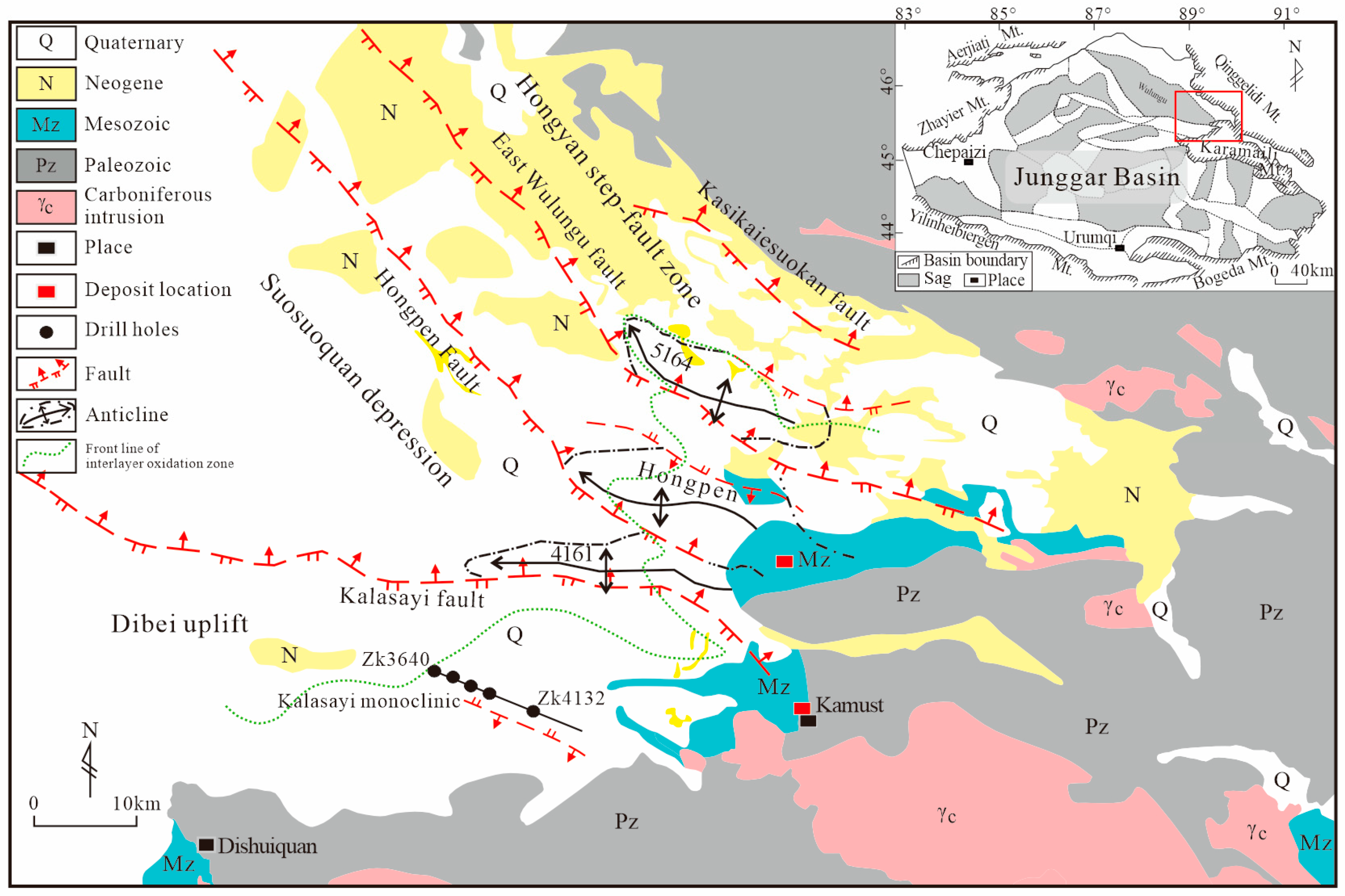
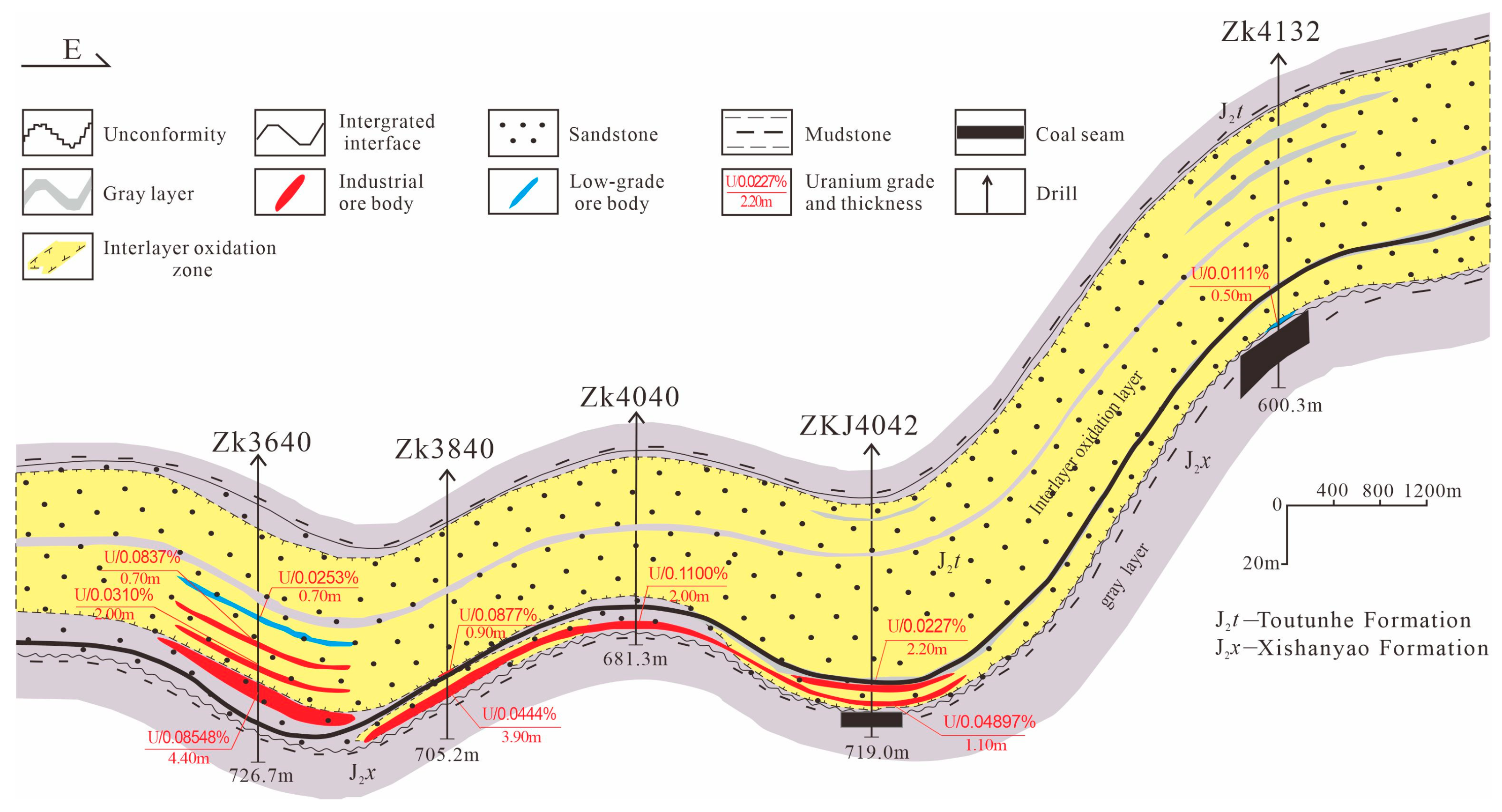

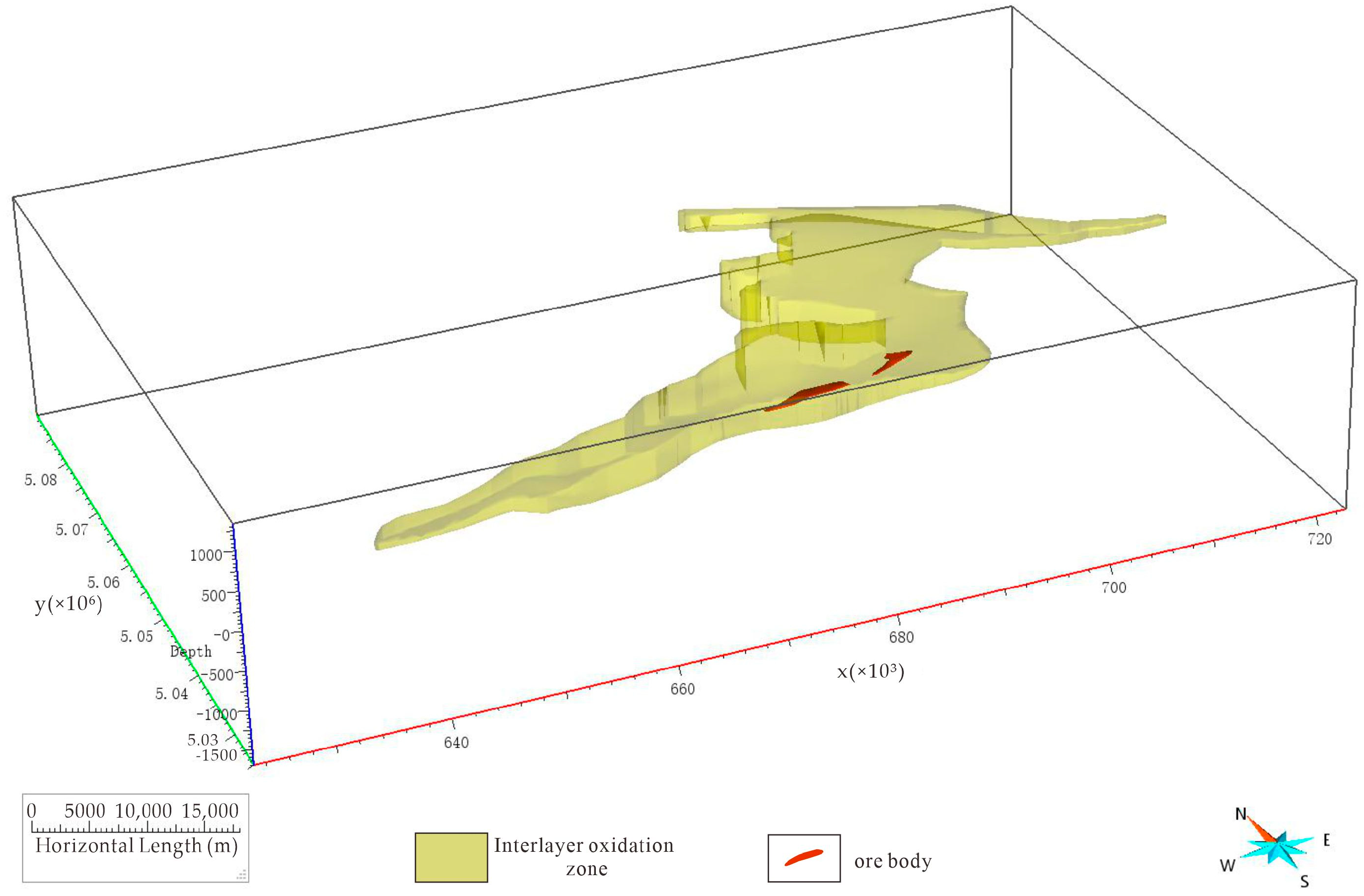
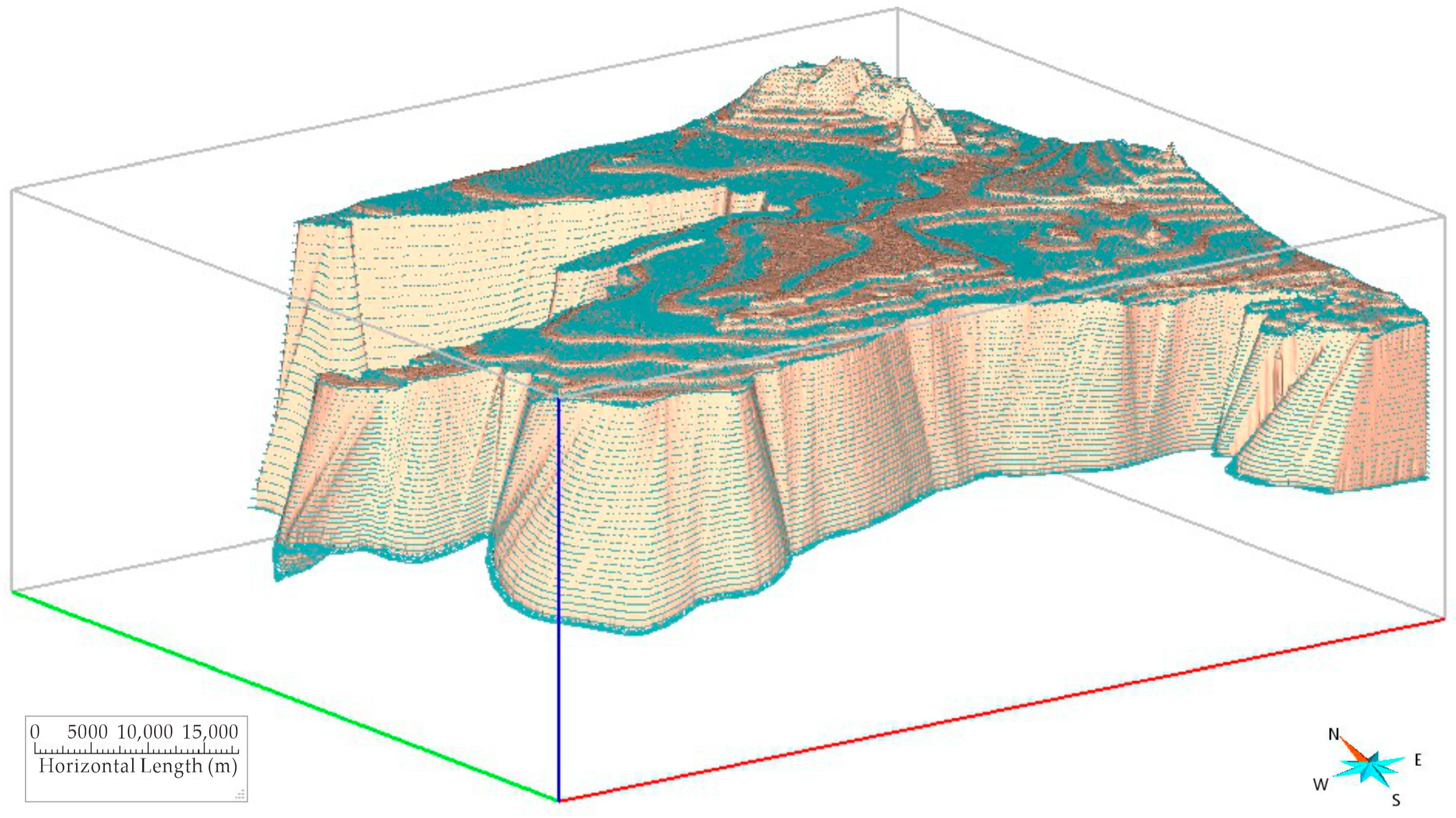

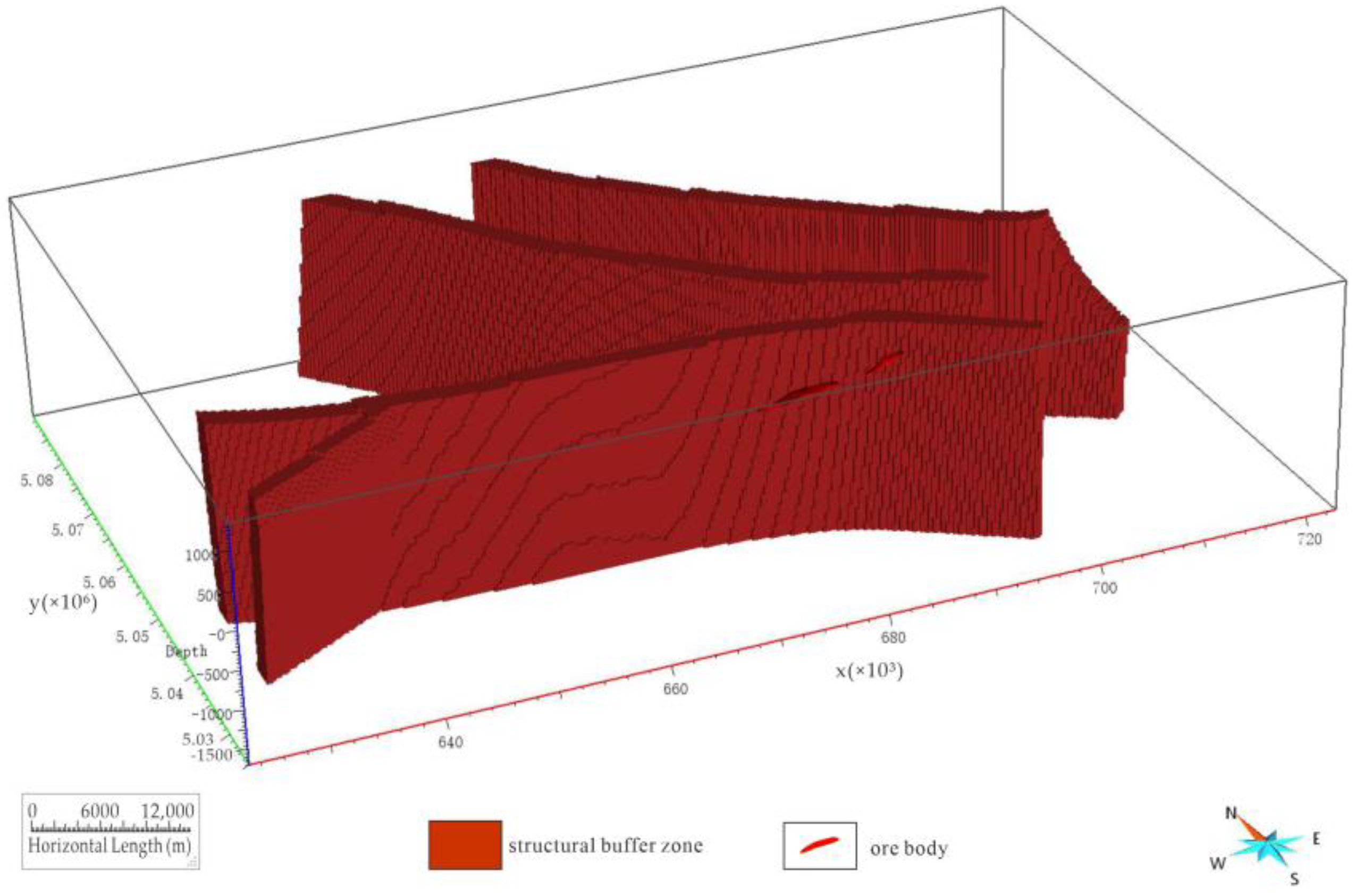
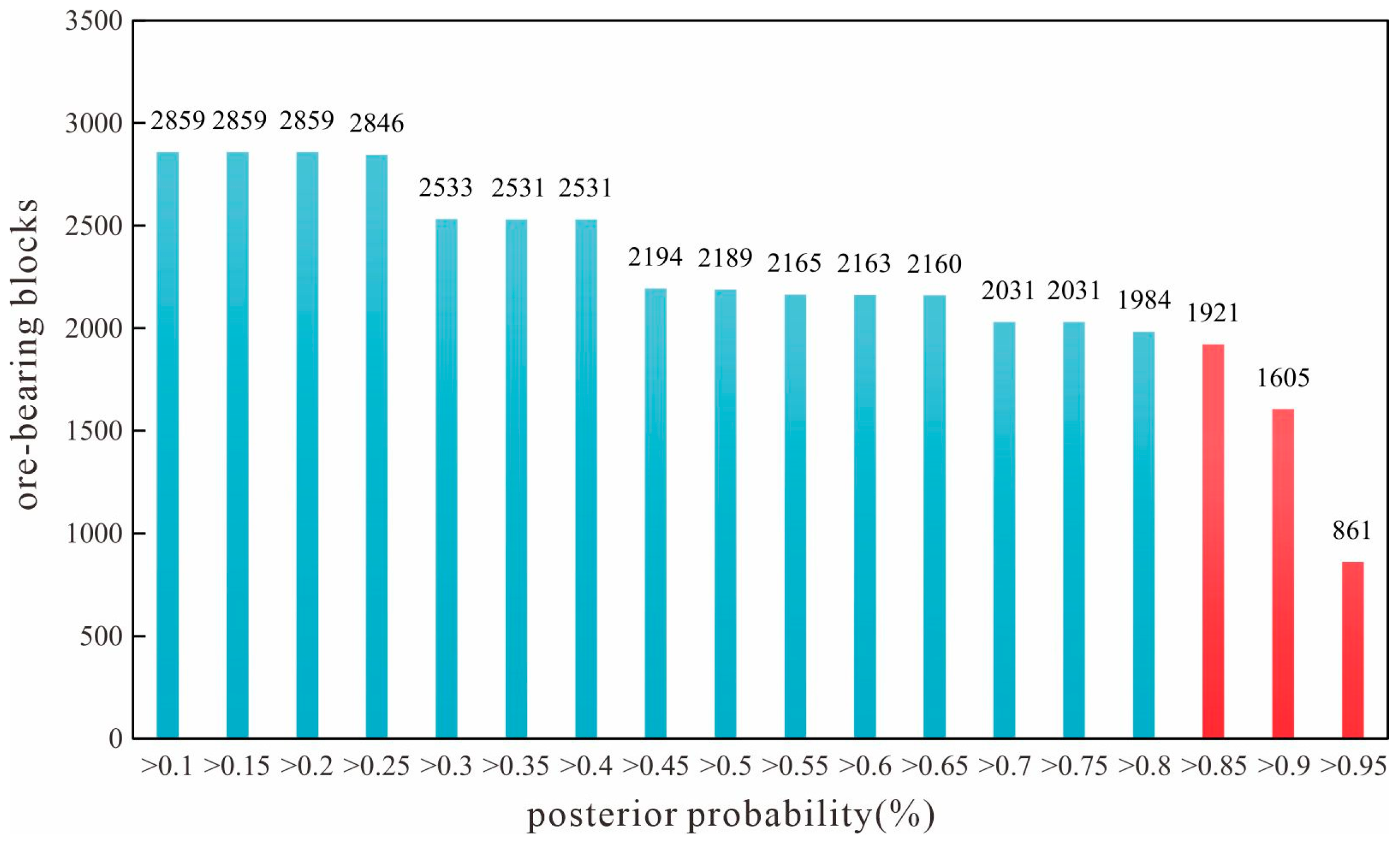

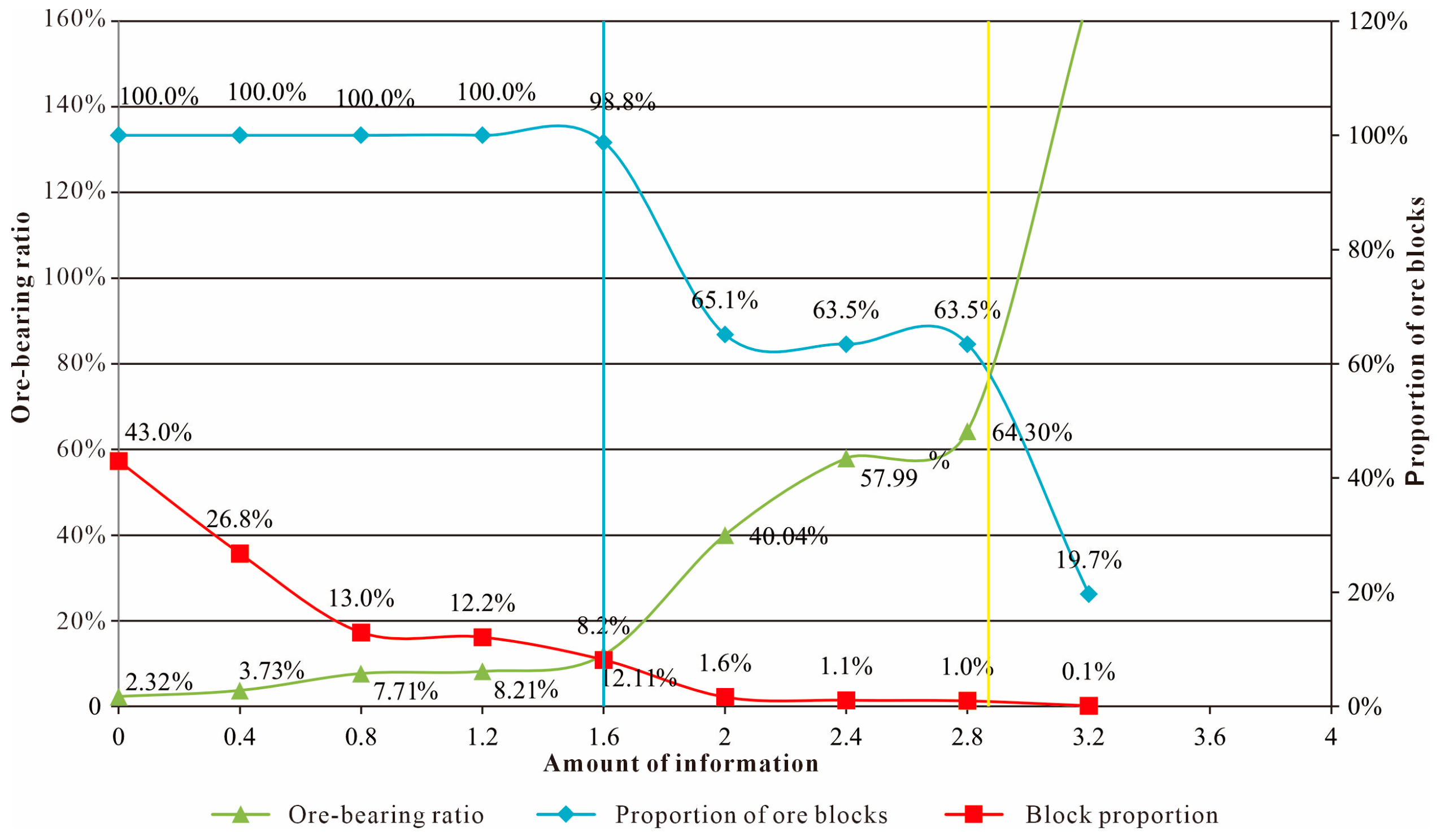
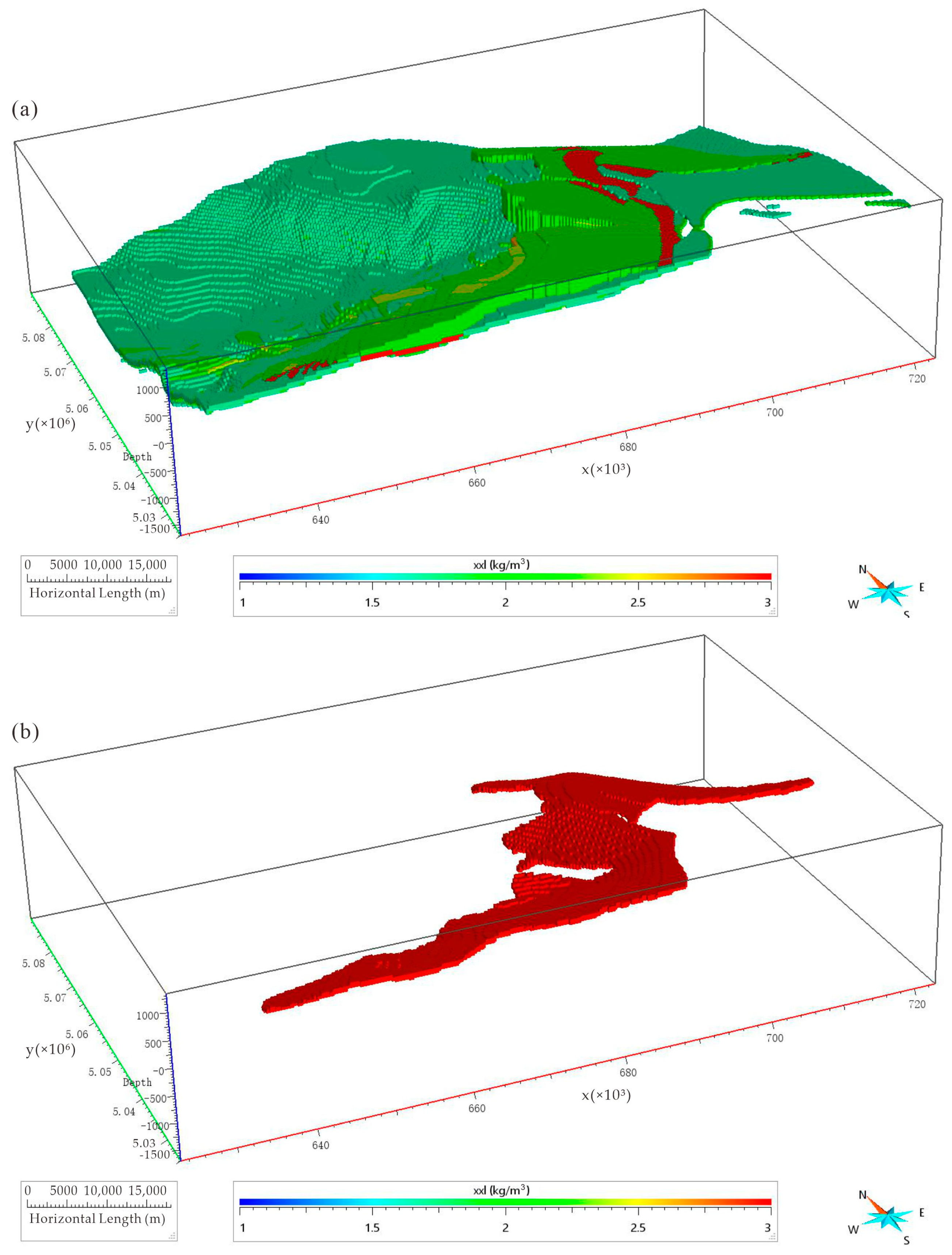

| Deposit Types | Ore-Controlling Factors | Geological Feature | 3D Spatial Reconstruction of Mineralization Anomalies | Characteristic Values |
|---|---|---|---|---|
| Sandstone-type uranium ore | Strata | Mineral-bearing characteristics of the stratum | Favorable ore-forming rock series; ore-bearing stratum | Sandstone layer; Toutunhe, xishanyao, and sanguhe formations: 200 m buffer zone |
| Structures | Tectonic zone characteristics | Fault buffer zone | 800 m buffer zone around faults | |
| Tectonic development and distribution characteristics | Azimuthal anomaly degree | (0.8~1) | ||
| Structural ore-controlling factors | Favorable ore-forming location | Ore-hosting space in slope belt of basin margin | ||
| Oxidation zone | Interlayer oxidation zone model | Ore migration pathway | Toutunhe oxidation zone |
| Information Layer Name | Number of Marked Units | Number of Information Layer Units | Amount of Information |
|---|---|---|---|
| Xishanyao Formation | 146 | 618,117 | 0.249034 |
| Toutunhe Formation | 402 | 600,610 | 0.701386 |
| Oxidation zone | 261 | 103,523 | 1.277356 |
| Inter-group buffer zone of Xishanyao Formation | 410 | 308,797 | 0.998863 |
| Fault Buffer Zones | 18 | 70,808 | 0.280942 |
| Azimuthal Anomaly | 51 | 140,897 | 0.432959 |
| Evidence Items | W+ | S (W+) | W− | S (W−) | C |
|---|---|---|---|---|---|
| F3 | 0.743396 | 0.223359 | −0.02596 | 0.050252 | 0.769357 |
| J2 | 0.608605 | 0.080842 | −0.23497 | 0.06166 | 0.843575 |
| J3 | 1.625091 | 0.04934 | −4.19494 | 0.444995 | 5.820032 |
| Interlayer Oxidation Zone | 2.944135 | 0.061617 | −0.97249 | 0.081099 | 3.916622 |
| ZJ-J2 | 2.303345 | 0.049059 | −8.92113 | 4.472136 | 11.22447 |
| Isodensity | −0.2725 | 1.880797 | 0.000454 | 0.049043 | −0.27295 |
| Frequency | −0.0371 | 0.149256 | 0.004852 | 0.051906 | −0.04195 |
| Azimuthal Anomaly Degree | 1.031453 | 0.137544 | −0.0893 | 0.052474 | 1.120753 |
| Amount of Information | Number of Ore-Bearing Blocks in Information Interval | The Ore-Bearing Proportion of Information Interval | The Difference of the Number of Ore Blocks in the Information Interval |
|---|---|---|---|
| >0 | 416 | 100.00% | 0 |
| >0.4 | 416 | 100.00% | 0 |
| >0.8 | 416 | 100.00% | 0 |
| >1.2 | 416 | 100.00% | 5 |
| >1.6 | 411 | 98.80% | 140 |
| >2 | 271 | 65.14% | 7 |
| >2.4 | 264 | 63.46% | 0 |
| >2.8 | 264 | 63.46% | 182 |
| >3.2 | 82 | 19.71% | 82 |
| >3.6 | 0 | 0.00% | 0 |
Disclaimer/Publisher’s Note: The statements, opinions and data contained in all publications are solely those of the individual author(s) and contributor(s) and not of MDPI and/or the editor(s). MDPI and/or the editor(s) disclaim responsibility for any injury to people or property resulting from any ideas, methods, instructions or products referred to in the content. |
© 2024 by the authors. Licensee MDPI, Basel, Switzerland. This article is an open access article distributed under the terms and conditions of the Creative Commons Attribution (CC BY) license (https://creativecommons.org/licenses/by/4.0/).
Share and Cite
Geng, Y.; Liu, Z.; He, Z.; Zhu, P.; Huang, S.; Ji, H. 3D Geological Modeling and Metallogenic Prediction of Kamust Sandstone-Type Uranium Deposit in the Eastern Junggar Basin, NW China. Minerals 2024, 14, 988. https://doi.org/10.3390/min14100988
Geng Y, Liu Z, He Z, Zhu P, Huang S, Ji H. 3D Geological Modeling and Metallogenic Prediction of Kamust Sandstone-Type Uranium Deposit in the Eastern Junggar Basin, NW China. Minerals. 2024; 14(10):988. https://doi.org/10.3390/min14100988
Chicago/Turabian StyleGeng, Yingying, Zhangyue Liu, Zhongbo He, Pengfei Zhu, Shaohua Huang, and Huali Ji. 2024. "3D Geological Modeling and Metallogenic Prediction of Kamust Sandstone-Type Uranium Deposit in the Eastern Junggar Basin, NW China" Minerals 14, no. 10: 988. https://doi.org/10.3390/min14100988
APA StyleGeng, Y., Liu, Z., He, Z., Zhu, P., Huang, S., & Ji, H. (2024). 3D Geological Modeling and Metallogenic Prediction of Kamust Sandstone-Type Uranium Deposit in the Eastern Junggar Basin, NW China. Minerals, 14(10), 988. https://doi.org/10.3390/min14100988








